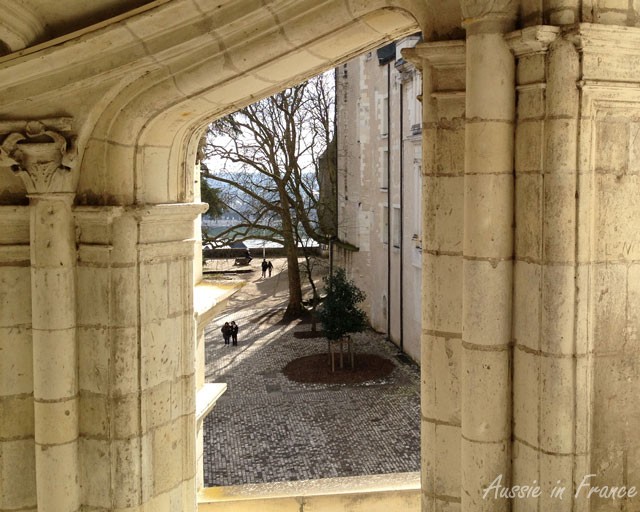

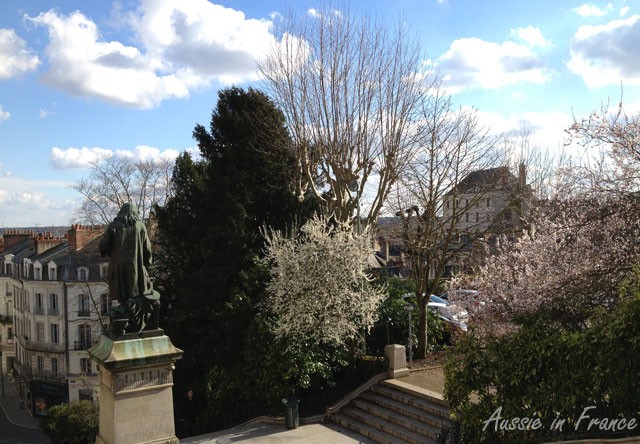
“She’s very mundane”, a bilingual French-English speaker said to me recently, obviously thinking that mundane means the same thing as mondain. To start off with, in English, we wouldn’t use mundane to describe a person, but rather something more abstract such as life or existence. Mundane means dull and ordinary or relating to ordinary life on earth rather than to spiritual things.
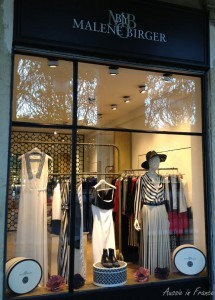
Mondain, on the other hand, relates to the social life of what the French now surprisingly call people and what we call celebrities. It also refers the social habits of the bourgeoisie in which relations and conversations are always superficial.
What my friend really meant to say is “She’s a socialite”. Whenever we want to express the idea of mondain, we nearly always need to have society or social in there somewhere.
Elle mène une vie mondaine = She’s a socialite.
Il a le goût pour la vie mondaine = He has a taste for society life (or the high life).
Ce festival est l’évènement mondain de l’année = The festival is the society event of the year.
“Mundane”, on the other hand, probably needs a different translation every time.
On a more mundane level = au niveau pratique
Mundane task = tâche courante
A mundane concern = préoccupation terre-à-terre
I’ve kept “mundane existence” for last because it’s a bit trickier as it has two meanings. A mundane existence can refer to a non-spiritual existence in which case it would be une existence terrestre or profane. However if we’re just referring to the fact that it’s dull and ordinary, we would say une existence banale ou une vie banale.
Speaking of banal, that’s another word which doesn’t mean quite the same in French and in English. Actually, it’s not the meaning that differs so much as the usage. Banal in English means commonplace or trivial, which is more or less what it means in French, particularly when it refers to a lack of originality. However, in English, we don’t say people are banal as we do in French; we say they’re ordinary or run-of-the-mill.
Un personnage peu banal = an unusual character
Une conversation or une idée banale = a trite or banal conversation or idea
Une vie banale could also be translated as a humdrum life.
Une grippe banale = a common case of flu
And to finish up, here’s a very common expression in French: Ce n’est pas banal.
How would you say it in English? And maybe you have some other examples (with their translations!) of mundane, mondain and banal.
This week’s Blogger Round-Up starts in the city of Nice on the French Riviera with Phoebe from Lou Messugo who shares her stunning photos of Nice Carnival. And to give you another view of Nice, Margo Lestz, writing for The Good Life France, explains the origin of The Bay of Angels and other place names. In a different part of the country altogether, Susan from Days on the Claise tells us the fascinating history of Van Loos’ painting of The Three Graces in Chenonceau. Enjoy!
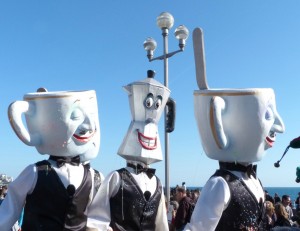 We couldn’t have asked for a more perfect day to go to Nice Carnival 2014. Under the bluest of blue skies we spent a fun afternoon watching the the creative, witty and satirical floats pass by united under the theme of gastronomy. Being our 5th or 6th time at Carnaval we recognised some of the regulars – the roaring dragon, the confetti seller who comes to the school fête, the OGCN (Nice football team) supporters with balloon boobs, the man dressed as a caveman hauling a ragdoll around, the Italian flag throwers – we felt like real locals. As always the floats represented contemporary issues and cultural icons. Amongst others Angela Merkel could be seen devouring Portugal, Spain and Greece. Read more
We couldn’t have asked for a more perfect day to go to Nice Carnival 2014. Under the bluest of blue skies we spent a fun afternoon watching the the creative, witty and satirical floats pass by united under the theme of gastronomy. Being our 5th or 6th time at Carnaval we recognised some of the regulars – the roaring dragon, the confetti seller who comes to the school fête, the OGCN (Nice football team) supporters with balloon boobs, the man dressed as a caveman hauling a ragdoll around, the Italian flag throwers – we felt like real locals. As always the floats represented contemporary issues and cultural icons. Amongst others Angela Merkel could be seen devouring Portugal, Spain and Greece. Read more
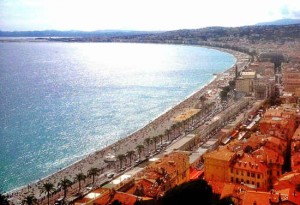 Many rich and famous tourists visit Nice every year, but according to a legend, the first visitors were actually Adam and Eve – yes, the ones from the Bible.
Many rich and famous tourists visit Nice every year, but according to a legend, the first visitors were actually Adam and Eve – yes, the ones from the Bible.
As the story goes, after they were kicked out of Paradise for being naughty, they were standing outside the locked gates looking at their new hostile surroundings. Everywhere was barren and inhospitable. They had no idea where to go or what to do. Then they heard the sound of rustling wings, looked up to see a band of angels flying overhead motioning to them. The angels flew across the waters and hovered over a certain spot – they were showing the couple a glorious bay, in front of a land that was as lush and beautiful as the Eden they could no longer enter. Read more
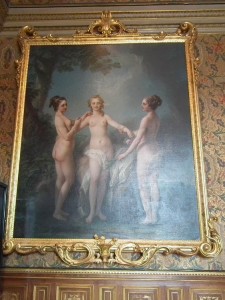 There is a large painting depicting three naked women hanging in one of the salons of Chenonceau. It’s called The Three Graces and is by Carle Van Loo (not his brother Jean-Baptiste, despite the frequency you will find it attributed to him on the internet). It is widely believed to depict three of the five de Nesle sisters, but since it is clearly a picture of three attractive young women, there is a certain amount of debate about the identification of the notorious sisters and the subject of this painting. The de Nesle sisters, with the exception of the youngest, were not considered to be beauties, were all long dead by the time the picture was painted and Van Loo wasn’t known for being kind to his subjects. Read more
There is a large painting depicting three naked women hanging in one of the salons of Chenonceau. It’s called The Three Graces and is by Carle Van Loo (not his brother Jean-Baptiste, despite the frequency you will find it attributed to him on the internet). It is widely believed to depict three of the five de Nesle sisters, but since it is clearly a picture of three attractive young women, there is a certain amount of debate about the identification of the notorious sisters and the subject of this painting. The de Nesle sisters, with the exception of the youngest, were not considered to be beauties, were all long dead by the time the picture was painted and Van Loo wasn’t known for being kind to his subjects. Read more
It’s been the strangest winter. I don’t think the temperature has gone below zero more than a couple of times and there has been absolutely no sign of snow. As a result, spring seems to have come a couple of weeks early.

We are in Blois for a month this time, the longest period yet so it feels more permanent. Things are starting to get more organised but I’m still finding it hard to reconcile my translation work and doing more interesting things such as gardening.
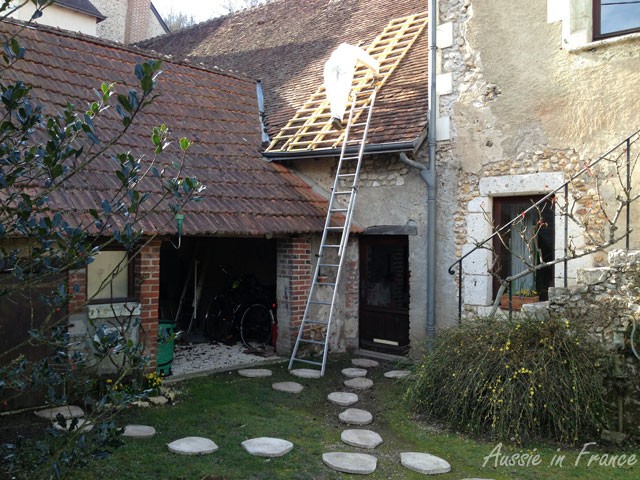
Also, having one person working and the other free to do what he wants with his time is not easy. Not that Jean Michel is lazing around – quite the opposite. Among other things, he has chopped firewood, completed the electricity in our upstairs kitchen, made two roof ladders and cleaned the moss off one of the roofs.
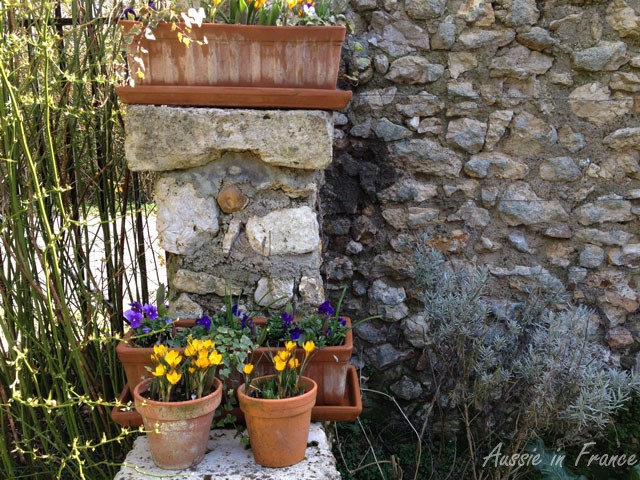
But we are having to adjust to a different pattern. In Paris, Jean Michel gets up earlier than me during the week – often around 7, and has his breakfast alone. I get up around 8.30, get dressed, have a quick breakfast and am in my office by 9.
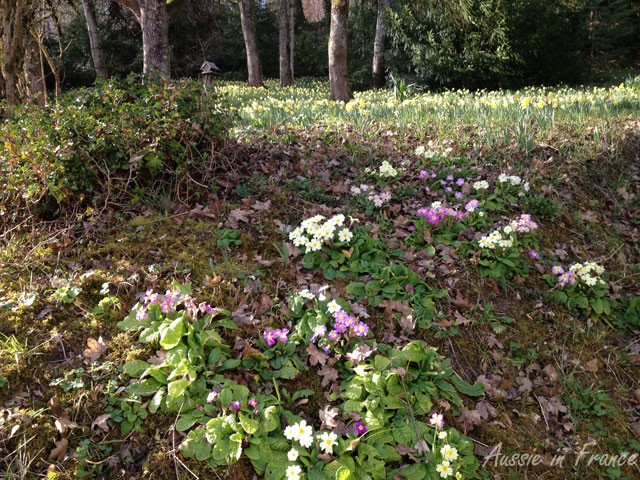
Here, if we get up at 8.30, I’m not sitting in front of my computer until closer to 10 because Jean Michel needs to take his time in the morning. I’ve been making an effort to get up at 8 but I only gain a half an hour and I’m tired! On intermittent fast days, it’s much easier as we skip breakfast. We’ve talked about it together and Jean Michel is also frustrated because he is a morning person and has the impression that he’s wasting his whole day if he doesn’t get up until eight (but he hasn’t suggested getting up earlier).

So I’m trying to schedule our two fast days for Monday and Friday and maybe I won’t eat on Wednesday mornings either. Then on the other two days, as soon as I’ve finished my breakfast I’ll leave him to it instead of taking time over tea together. The weekend’s not a problem of course.
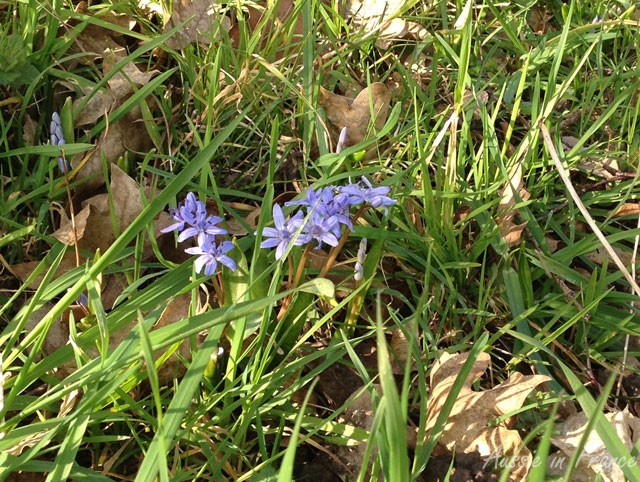
Jean Michel also has a short nap after lunch and goes to sleep before I do at night, so all in all, I’m not getting enough sleep, and am exhausted! I hope we’ll have solved the problem soon. At least having a whole month in Blois means that we can get into better sync before the final move in October.
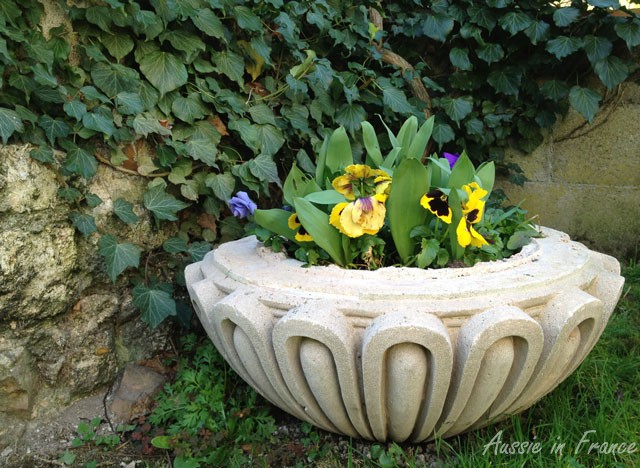
The fact that it rained most days last week didn’t help either. We were nice and wet by the time we finished the market on Saturday morning then spent the afternoon chasing after things like bottle racks and mats to scrape the mud off our shoes. By that evening we were feeling a little jaded.
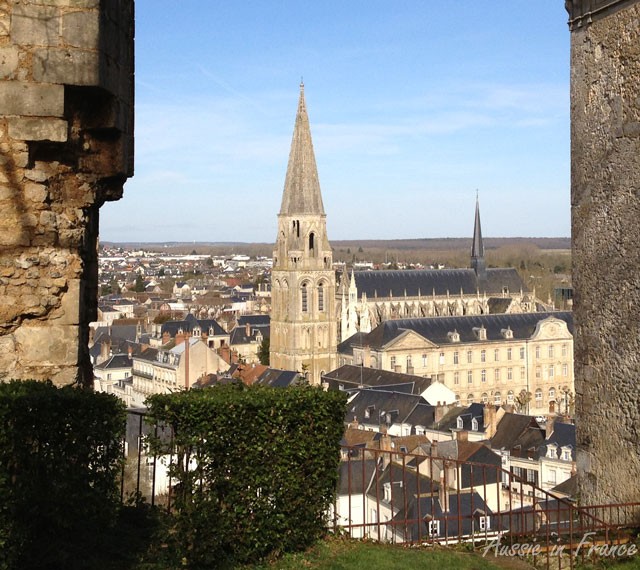
However, Sunday dawned fine and sunny and after a leisurely breakfast, we drove to Vendome which is really pretty. Clouds came over around midday, to our disappointment. But by the time we had finished a very good lunch at Le Rond de Serviette, the sky was blue again and we walked up the hill to see the stunning panorama.
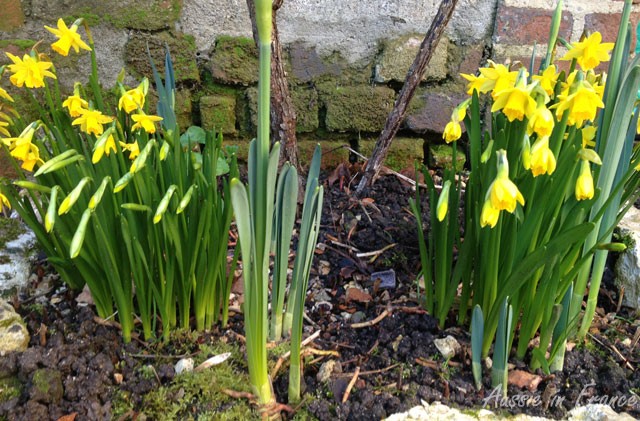
We arrived back home just in time for a late tea and macarons in front of the fire. It felt as though we were on holidays because it’s exactly the way we used to spend the day when we stayed in a gîte with a fireplace in winter before we bought Closerie Falaiseau.
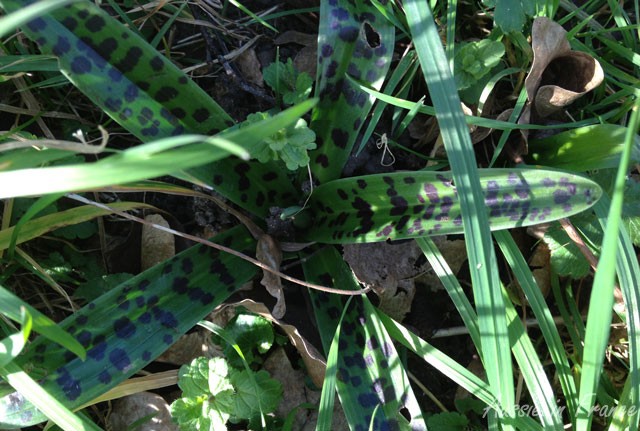
Oh, and I nearly forgot – the annoying neighbours with the poultry yard have packed up, lock, stock, barrel and chickens. We couldn’t believe our luck! We expect that someone else will move in soon, perhaps at the end of the month. Let’s keep our fingers crossed.
Considering the number of canals that run through it, I’m surprised that the mediaeval town of Vendôme on the Loir River (not the same as the Loire), 35 k from Blois, is not called the Little Venice of Beauce after the surrounding flat wheat country. It turned out to be unexpectedly pretty. Every time we turned a corner, we saw a little canal, an archway or a tiny street lined with architectural marvels. Although it was bombed during World War II and many of its half-timber houses destroyed, much of its mediaeval architecture has survived. Although we started out sunny, clouds came over during the first part of the day but after lunch the blue sky returned and the panorama from the ruined castled above the town was quite striking.
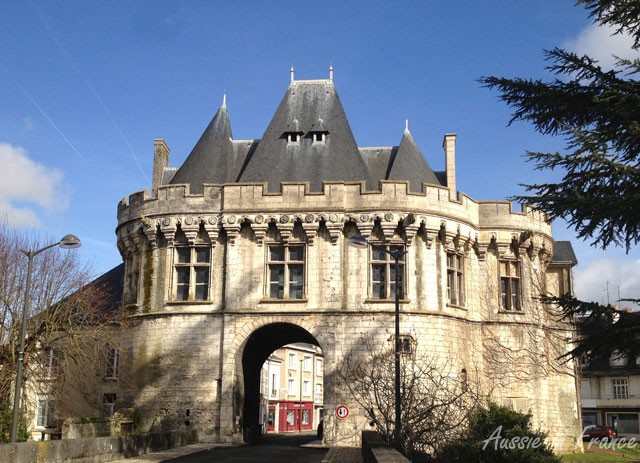
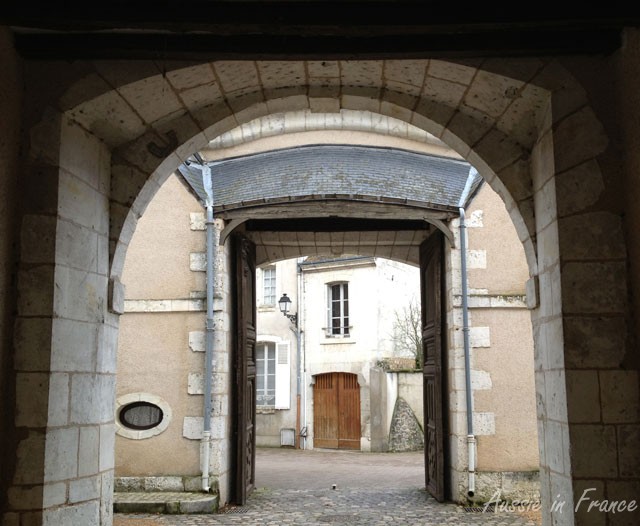
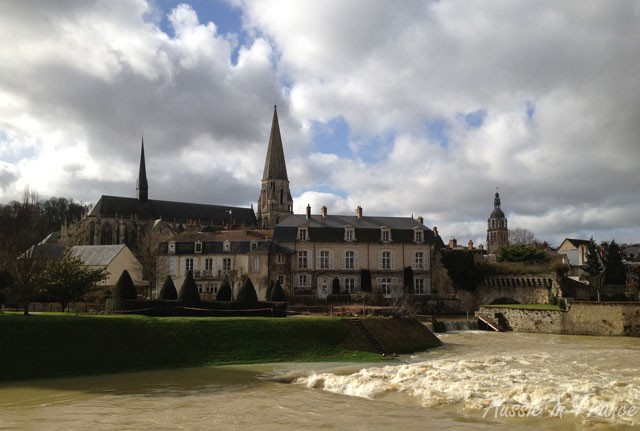
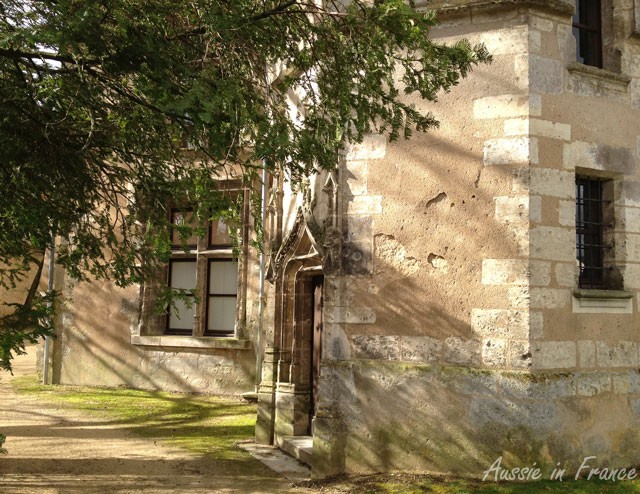
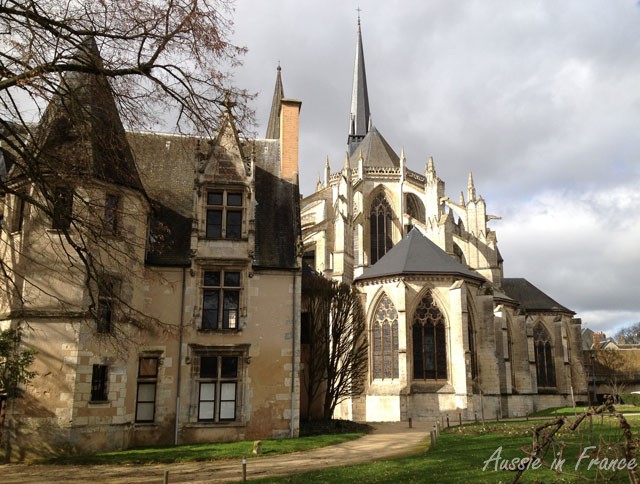


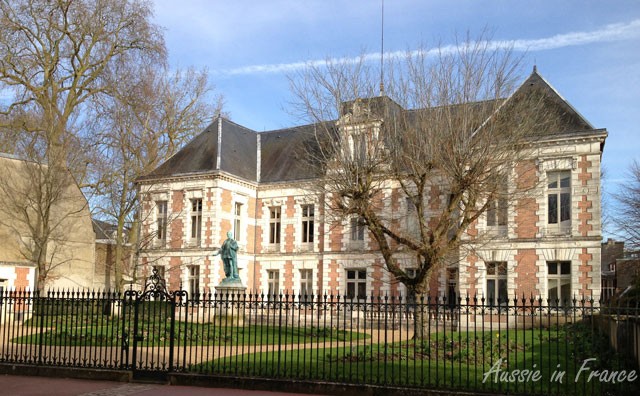
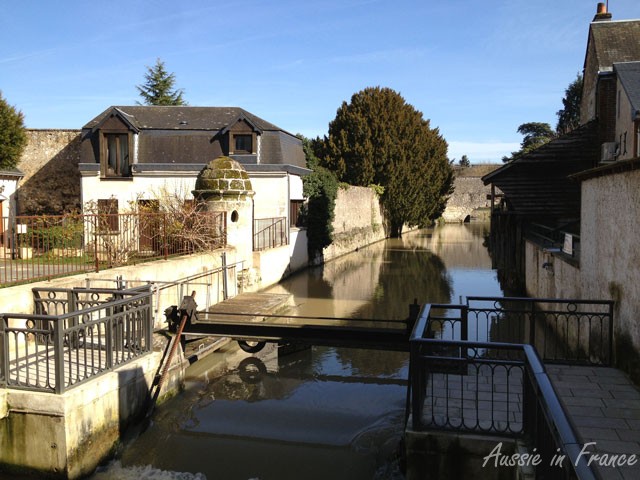
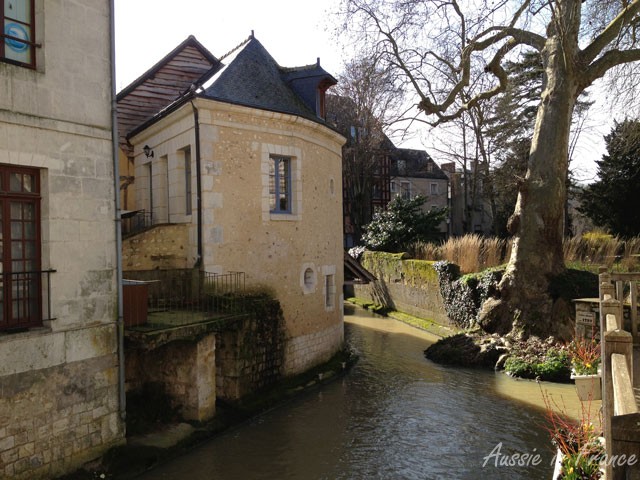
We had an excellent lunch at Le Rond de Serviette, a recently opened restaurant on Rue Poterie with excellent reviews. Main dish under 10 euro. Friendly service.
Anglosaxons do a lot of walking – well, at least in theory!
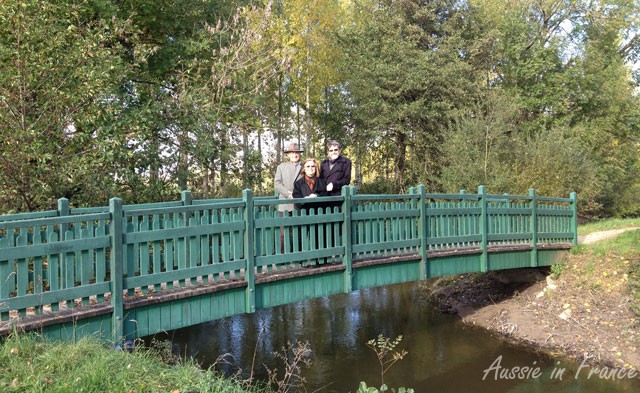
We walk to the bakery. We go for a little walk. We walk in the country. We do a 10 kilometer walk. We take the dog for a walk. We walk someone home. We go on a long walk to see a castle. We walk home in the dark.
So, with all this walking, many people look for a verb in French which will be just as handy. Only there isn’t one!
On va à la boulangerie à pied. On fait un petit tour. On se promène à la campagne. On fait une promenade de 10 kilomètres. On promène le chien. On accompagne quelqu’un chez lui. On fait une excursion à pied pour visiter un château. On rentre à pied avec la nuit.
Note that unless you’re walking the dog (or someone else, such as a child or your aged grandmother), se promener is always reflexive.
And have you noticed that, so far, we haven’t used marcher which is what we all learn at school to mean “walk”!
So when do we use marcher?
Let’s go back to the bakery. If I were to say, “I walked right to the bakery”, I could use marcher: j’ai marché jusqu’à la boulangerie. I could also say Je suis allé jusqu’à la boulangerie à pied.
You can use promenade for 10 kilometers if you went at a leisurely pace, but you’d say J’ai fait une marche de trois heures if you want to convey the idea that you were getting a lot of exercise. A 6-hour walk becomes a randonnée. I’m not quite sure though what the cut-off point is!
J’ai les jambes lourdes, je vais marcher un peu. My legs feel heavy. I’m going to walk for a bit.
Il marchait sans but. He walked aimlessly.
Elle marche en boîtant. She limps. You can also say Elle boîte but that would be a general statement and give the idea that it’s something permanent. Subtle, huh?
Il marche toujours à grands pas. He always strides along.
Le bébé marchait à quatre pattes. The baby was crawling. Now that’s a good one! And when baby takes her first steps, elle prend ses premiers pas. She walked at 9 months (yes, one of my did!) = Elle a marché à 9 mois.
Avec elle, il marche sur des oeufs. Literally, “with her, he walks on eggs” but we’d be more likely to say something like “He always treats her with great caution” or “He always skirts around her”.
And here’s an interesting proverb to finish up: C’est marche ou crève! It’s sink or swim (literally “it’s walk or die”).
I’m sure you have some other examples to share.
It’s our second day in Blois and Susan and Simon from Days on the Claise have invited us to their local saffron fair. I know next to nothing about saffron except that it comes from the pistils ofcrocuses. Even that’s not right – it actually comes from the stigmas which are a part of the pistils.

The day’s not brilliant but at least it’s not raining. We’re amazed at the high water level in the fields as we get closer to Preuilly which is about an hour and a half from Blois through Montrichard and not far from Loches.
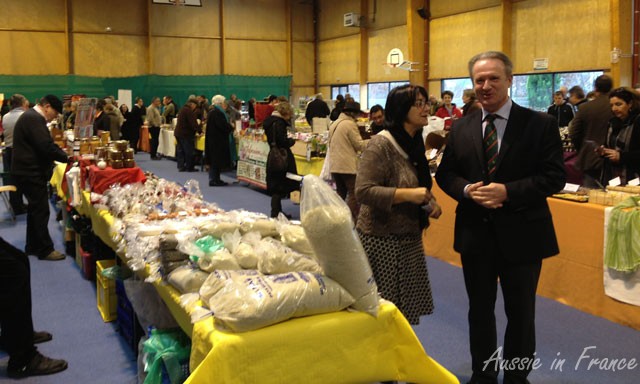
After inspecting Simon’s recent staircase varnishing job, we walk down to the gymnasium. Inside it’s all hustle and bustle with lots of gaily decorated stalls, not all selling saffron, I’m surprised to see, but then, there’s only so much saffron you can use in a year, isn’t there?
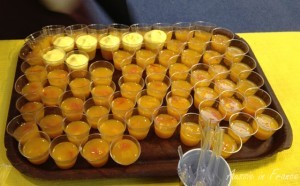
We pay for our saffron-themed lunch (18.50 euro) – Susan has already booked our table – and start sampling some little verrines but we can only remember one of them now: queen’s scallop in pumpkin soup flavoured with saffron.
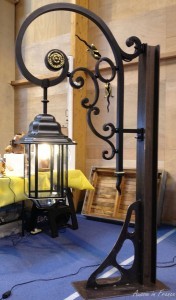
There are all sorts of goods on sale. The first stop is a wrought-iron craftsman. I wouldn’t mind having a lamp post like this one but it’s a little expensive …
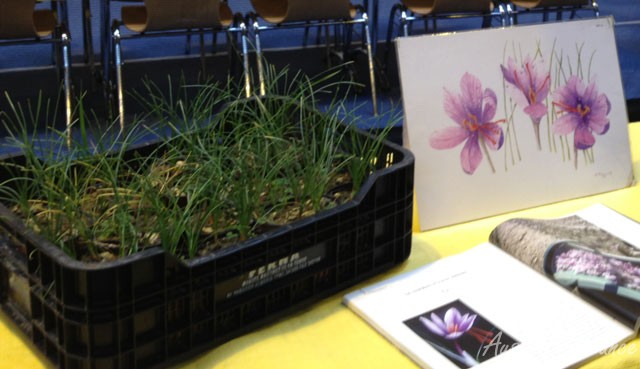
The next stand has some crocus plants on display. Although saffron crocuses have been cultivated in Touraine since the Middle Ages, no one really knows where they come from. Some think Tibet. You need 150 to 200 flowers to obtain 1 gram of saffron which explains why you should never buy powdered saffron – it’s probably something else altogether!
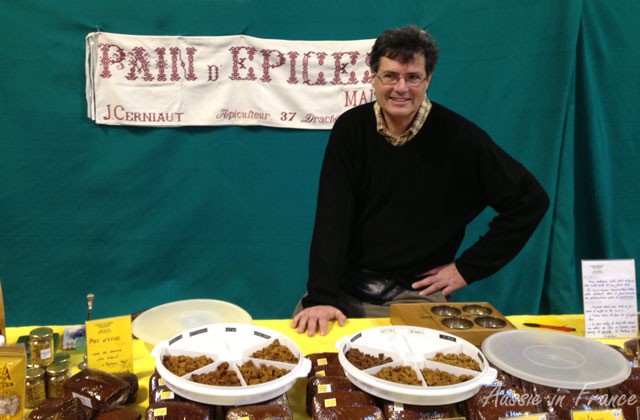
Several stands are selling pain d’épices flavoured with saffron. I learn that you always infuse the stigmas in a liquid such as water, milk, cream and wine and add them at the end of the cooking time. Too high a heat destroys the aromatic molecules.

Another lady is selling unusual fruit and vegetable seeds so I buy some tubers called mashua (tropaeolum tuberosum) that were already being served up 5500 years in South America. I’ll let you know how they turn out!
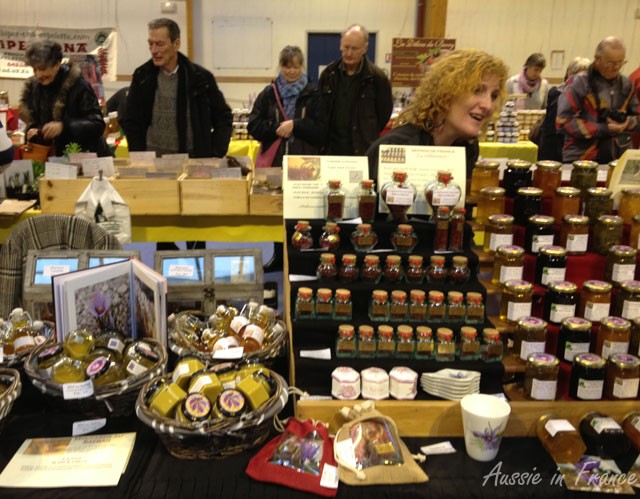
Next stop is a stand selling little bottles of saffron-flavoured vinegar, honey, jam, etc. I buy a few to keep as gifts and am given a neat little jute carry bag.
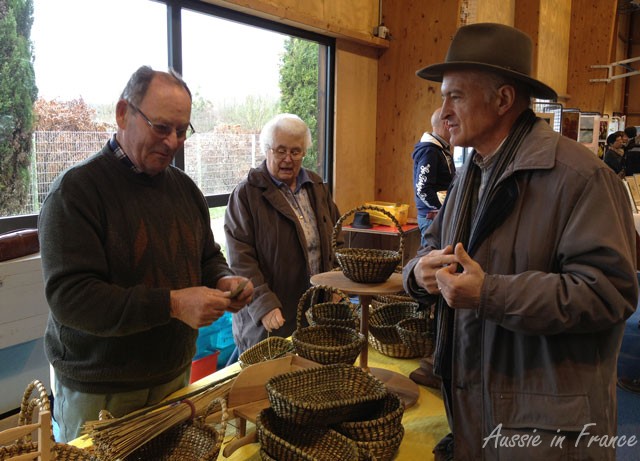
We are intrigued by a man selling baskets that he makes using local rushes and brambles. They start out green and gradually become brown. The basket-maker explains that it’s a pensioner’s hobby and that he only sells the baskets to make room for more. At 10 euro a basket, it’s a bargain. They are all beautifully finished. I choose one that turns out to be exactly the right size for our local pain aux céréales.
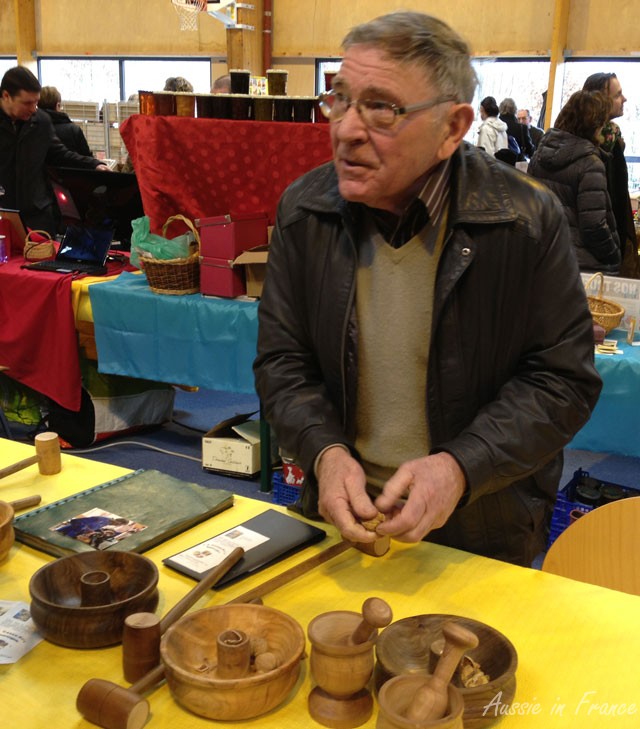
Another man is selling the same type of nutcracker we have at home that I think is perfectly useless so I get him to demonstrate. Obviously I’ve been using the wrong technique. I can’t wait to get back to Paris to see if I can crack perfect nuts without putting the shells all over the kitchen.
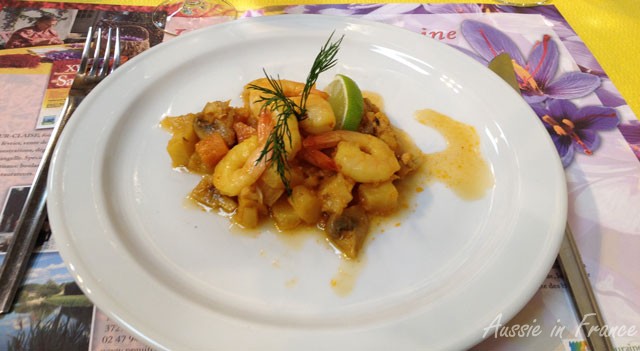
By now it’s lunchtime and my feet are killing me so we make our way to the dining area. We have a prawn-based entrée with saffron (which is often used to accompany mussels, scallops and fish), followed by guinea-fowl and saffron cream sauce.
Dessert is a local saffron-flavoured version of tiramisu which is one of my very favourite desserts. We choose a local crémant followed by a local sauvignon.
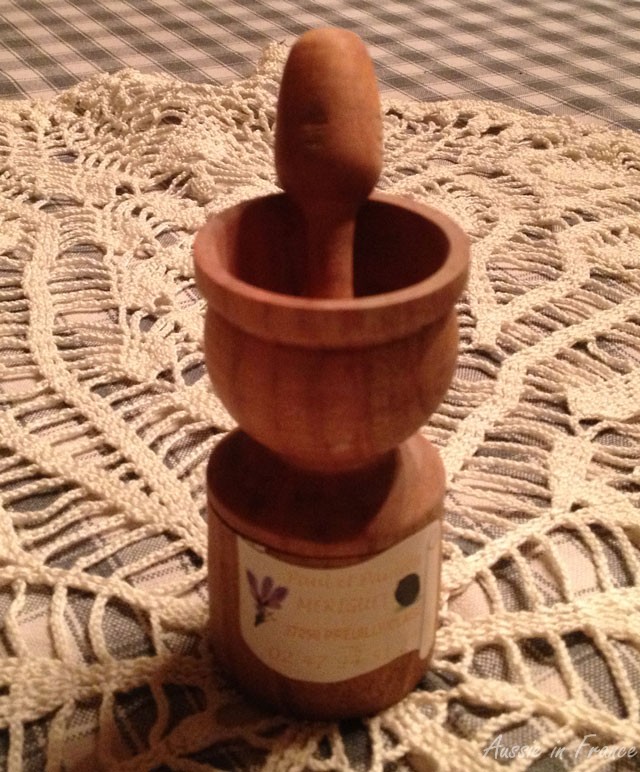
We don’t buy any saffron at the fair because Susan gives me a special little saffron container with a mortar and pestle on top made by friends in Preuilly. Jean Michel has picked up various brochures along the way, many of which contain saffron recipes. Since tomorrow is a fast day, I’m going to try an omelette au saffran.
In this week’s Blogger Round Up, Carolyn from My Sydney Paris Life shares nine big reasons to love Paris in winter (even though it hasn’t snowed this year); Jo Karnaghan from Frugal First Class Traveler takes us to Istanbul in the first of a series of posts, while Mind Body Green gives ten very interesting eating rules followed by French children. Enjoy!
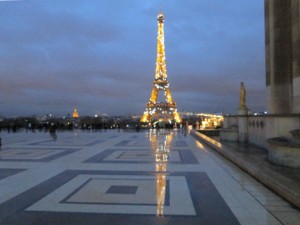 With our global family and so many destinations on our ‘we should go there’ travel list, I’m often wishing we could physically be in more than one place at one time. I miss family members, I miss my share of special events, and I miss Paris.
With our global family and so many destinations on our ‘we should go there’ travel list, I’m often wishing we could physically be in more than one place at one time. I miss family members, I miss my share of special events, and I miss Paris.
Paris is a favourite destination any time of year. Here are nine big reasons I’m missing Paris in winter. Read more
 I don’t know about you, but when I travel to a new place I always some preconceived ideas about what I am going to experience. My trip to Istanbul was no exception. I was delighted to discover some of my preconceptions exceeded my expectations, and some of my negative preconceptions were just plain wrong!
I don’t know about you, but when I travel to a new place I always some preconceived ideas about what I am going to experience. My trip to Istanbul was no exception. I was delighted to discover some of my preconceptions exceeded my expectations, and some of my negative preconceptions were just plain wrong!
I wrote previously about how much I enjoyed my hammam experience at Ayasofya Hurrem Sultan Hamami. While I was looking forward to going to the hammam, I didn’t realise just how enjoyable it would be. A good session at a reputable hammam really is like a wonderful treat at a very exotic spa. If you like massages, facials and other spa treatments, I thoroughly recommend a trip to the hammam – there really is no experience like it! Read more
How the French eat, age, dress, raise their children and live in general is a real talking point these days. So, as an American mother of three half-French kids, I figured I’d add my two cents to the conversation.
I lived in France before becoming a parent, but eventually it was my kids who taught me everything I need to know about eating like a French person: Eating, and staying slim and healthy, isn’t just about what you eat, but also how, when and why. Yes, French people enjoy junk food occasionally, and sometimes they eat between meals, but people don’t just let loose every day. There’s a code of conduct for food, for big people and little ones alike. Here, in 10 quick life lessons, is what my kids taught me about food. Read more
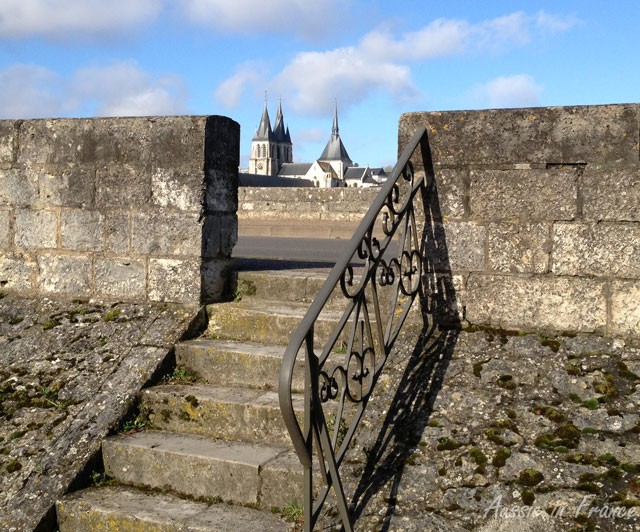 We arrived in Blois on Friday and are here for a month, the longest we’ve ever stayed. This morning, we were rewarded with bright sun and blue skies so we went for a walk on the other side of the Loire River. The church is that of Saint Nicolas, probably the most noticeable monument in the city while the church in the header photo is the Cathedral.
We arrived in Blois on Friday and are here for a month, the longest we’ve ever stayed. This morning, we were rewarded with bright sun and blue skies so we went for a walk on the other side of the Loire River. The church is that of Saint Nicolas, probably the most noticeable monument in the city while the church in the header photo is the Cathedral.
For more photos of Blois, click on my other blog, Blois Daily Photo, which has a commentary in French and English.
And just to fill you in on the chicken situation: in January, we noticed that the enclosure was open during the daytime and so was the front gate. The half-a-dozen chickens run around the large yard and sometimes out into the street. There was a not-too-annoying rooster last time as well but we haven’t heard it this time. So unless the neighbours change their minds again, the chickens should no longer be a problem. We won’t have a noisy smelly poultry yard next door in the summer. We, have, however, learnt our lesson and will put the garden of the gîte behind it and not in front of it. It will actually be much prettier.
How could I not talk about aimer on Valentine’s Day?
My first French boyfriend, many moons ago, told me that je t’aime beaucoup was not as strong as je t’aime on its own which seemed very strange to me. I already knew that je t’aime bien means “I like you” rather than “I love you” but I was surprised that je t’aime beaucoup didn’t mean “I love you very much”.
I was therefore equally surprised the first time Jean Michel said Je t’aime beaucoup. I explained what I had been told but he said he’d never heard of it. Yet my Collins/Robert bilingual dictionary says that aimer beaucoup means to like very much or to be very fond of. So who am I to believe?
Il l’aime d’amour means he really loves her. Elle est amoureuse means she’s in love. Il l’aime à la folie means he’s crazey about her or he adores her. Ils s’aiment means they love each other or they’re in love. Elle est amoureuse (de lui) = She’s in love (with him).
If je t’aime bien means “I like you”, how do you make the distinction between like and love when you’re not talking about people? For example, how would you say “I like chocolate” as opposed to “I love chocolate”? Well, you could say J’aime bien le chocolat or j’aime le chocolat and j’adore le chocolat.
There is no mistake about the last one – it means you’re a chocoholic (which incidentally is an accro au chocolat, accro being short for accroché meaning addict). J’aime bien le chocolat means you can take it or leave it and j’aime le chocolat means you like eating chocolate.
J’adore is one of the expressions that you hear all the time in French so much so that it is easy to forget that we don’t use “adore” in English in the same sense. You adore your children (well, most of the time), you worship the Lord (if you’re a believer) but you can only love chocolate.
J’adore le cinéma. J’adore le fromage. J’adore tout ce qui est français. J’adore sa façon de s’habiller. J’adore tremper mes tartines dans le chocolat chaud (I love dunking my bread in hot chocolate). You could go on forever …
If aimer is followed by mieux, it means “prefer”. J’aime mieux lire que d’écrire = I prefer reading to writing.
Love, of course, is amour but love at first sight is a coup de foudre or stroke of lightening, which is much more graphic, isn’t it?
All my love, Patrick = bises, Patrick while love and kisses or xxx = bisous, gros bisous ou grosse bises. However, if you want to say “Mark sends his love”, you’d say Marc t’envoie ses amitiés ou Marc t’embrasse, which is stronger.
In French, passion is often used to express love, but surprisingly, it usually applies to a hobby or passtime. Le théâtre était sa grande passion = the theatre was her (or his) great love. Sa première passion a été le foot = His first love was football.
He is the love of my life = c’est l’homme de ma vie but football is the love of her life = le foot est sa grande passion. Don’t you think that’s funny?
And here’s a proverb before we go. Love me, love my dog = Qui m’aime aime mon chien.